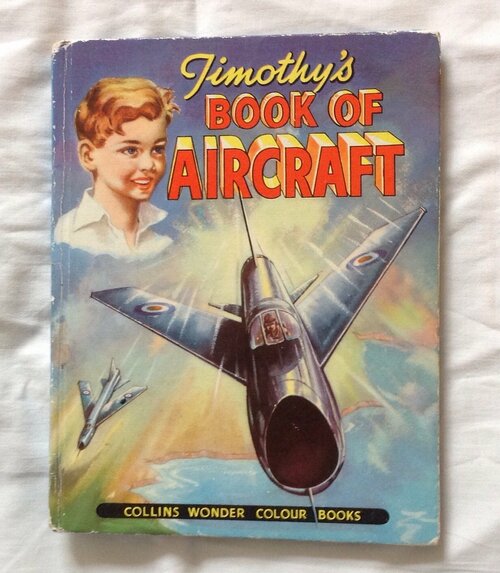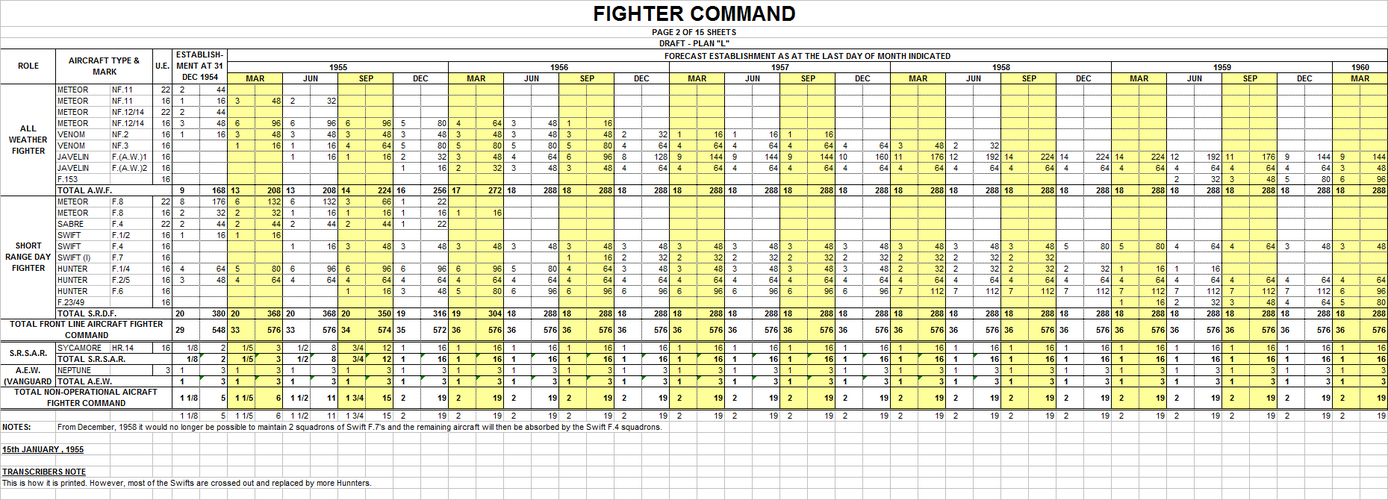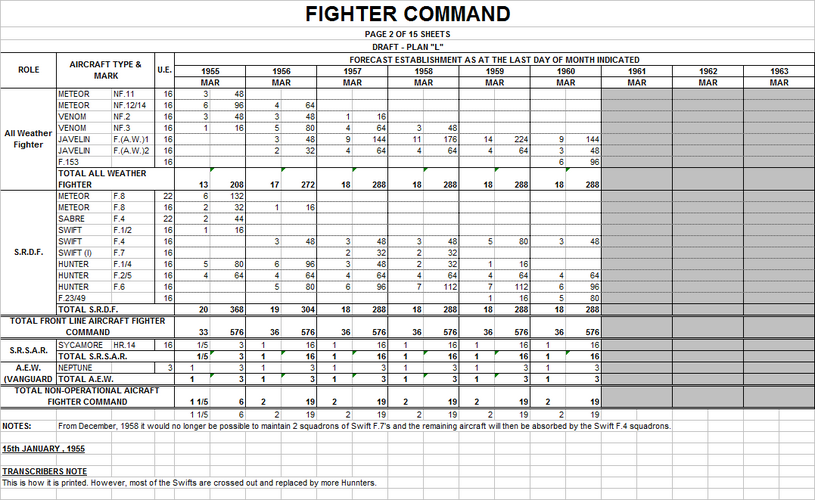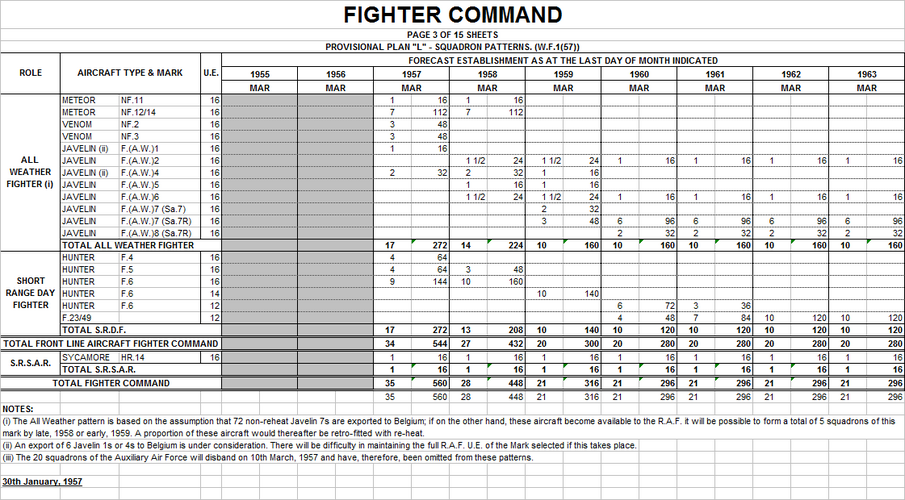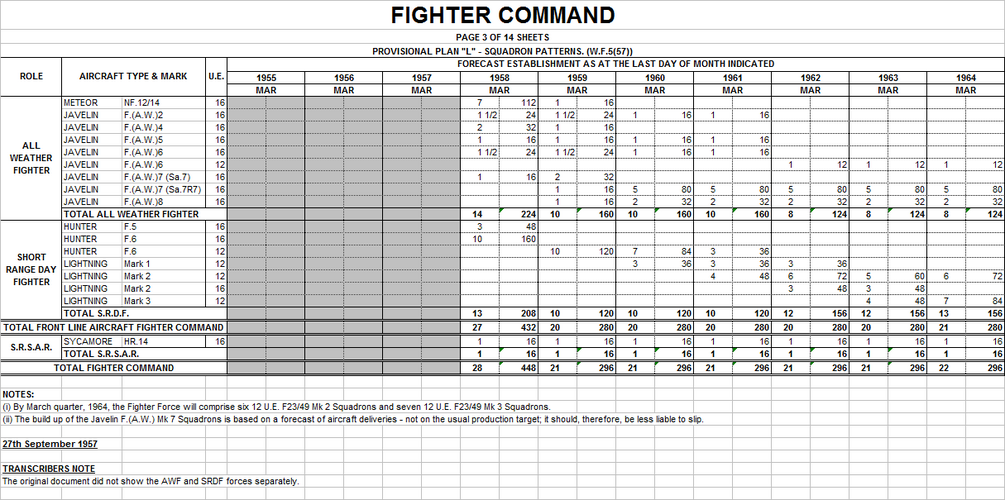Philip Birtles claims on Page 93 of Postwar Military Aircraft: 5 De Havilland Vampire, Venom and Sea Vixen that a total of 13 DH.110 prototypes were planned by the Ministry of Supply in April 1949 as follows:
- 7 night fighters for the RAF
- 2 long range fighters for the RAF
- 2 night fighters for the RN
- 2 strike fighters for the RN
He also said that 4 prototypes of the competing Gloster G.A.5 were ordered.
However, he wrote on Page 94 that the RN pulled out in November 1949 for financial and political reasons in favour of the Sea Venom to replace the Sea Hornet while the RAF order was reduced to 2 DH.110 and 2 G.A.5.
I've only found serials for 5 DH.110s including three (WG247, WG249 and WG252) that were cancelled leaving:
- WG236 which first flew on 26/05/51 and infamously crashed on 06/09/52 at the Farnborough Air Show killing 29 spectators and injuring many others.
- WG240 which first flew on 25/07/52. According to the UK Serials website this aircraft became went to Arbroath on 13/02/59 for Ground Instruction as A2481, then it went to Manadon, Plymouth during 1962 and was scrapped on 05/07/65.
The RN became interested in the aircraft again and WG240 landed on Centaur on 23/09/54.
Meanwhile, XF828 a semi-navalised prototype was ordered in February 1954. It had Avon 208 engines rated at 11,230lb thrust which was considerably more powerful than the 7,500lb thrust RA7 Avons that WG236 and WG240 had. It made its first flight on 20/06/55 and the first deck landing trials were carried out on Ark Royal on 05/04/56. According to the UK Serials website this aircraft went to Culdrose on 28/11/60 for Ground Instruction as A2500 and perished in 1978.
The first production order was placed in January 1955 and covered a total of 78 aircraft including a pre-production batch of 21 aircraft. The aircraft was officially designated the Sea Vixen on 05/03/57. XJ474 the first aircraft was rolled out in February 1957 and made its maiden flight on 20/03/57.
Intensive flying trials were carried out by 700Y flight which used a total of 8 Sea Vixens. This unit became 892 Squadron on 02/07/59 and embarked on Ark Royal on 03/03/60 for sea trials and transferred to Victorious later in the year.
I haven't checked, but if I remember correctly Friedman wrote in British Carrier Aviation that the DH.110 and what became the Scimitar were originally planned to enter service in 1953 and 1954 respectively. I think it's reasonable to assume that a 1953 Sea Vixen would have been a considerably less capable aircraft than the 1960 version. It would have less powerful engines, i.e. Avons or Sapphires in the 7,500lb thrust class like WG236 and 240 instead of the 10,000lb thrust class. It's radar and other avionics would not have been as good. The main armament would have been four 30mm ADEN cannon instead of four Firestreak AAMs.
However, the 1953 Sea Vixen would have been a considerable improvement over the Sea Hornet which was the RN's night fighter in that year and a lot better than the Sea Venom which became operational in 1955.
Birtles in his chapter on the Sea Venom doesn't give an order date for the aircraft. However, WK376 the first of 3 prototypes flew on 19/04/51 and commenced carrier trials on Illustrious on 09/07/51. The first production aircraft flew on 27/03/53 or 4 years to the week before the first pre-production Sea Vixen. 890 Squadron exchanged its Attackers for Sea Venoms on 20/03/54 but was downgraded to second-line status as 766 Squadron on 18/10/55. The next squadrons were 890 which converted from Sea Hornets to Sea Venoms in May 1954 and 891 which received its first Sea Venoms in November. Both of these squadrons were receiving the improved FAW.21 by May 1955. However, the author doesn't say when these squadrons embarked on an aircraft carrier as operational squadrons. My guess is sometime in 1955 which is about 5 years before the Sea Vixen.
Had the RN stuck to the DH.110 instead of the Sea Venom and DH.116...
The original order for 5 prototypes isn't cut back from 5 to 2 in 1949 and the order for the Mk 20X is brought forward to February 1950. The first prototype flies on the same date as the real world but the others (including the Mk 20X) are flying by the end of 1952. The first production contract (which includes 21 pre-production aircraft) is brought forward to January 1951 and the first of these flies in February 1953 instead of February 1957. All other things being equal the first operational squadron would form in July 1955 but wouldn't be fully worked up until late 1956.
This version of the Sea Vixen would have the same airframe and engines as the "real world" FAW.1 of 1960 but it probably has a less advanced radar and won't have Firestreak missiles.
However, the Sea Vixen and Scimitar could only be operated from Standard C or better aircraft carriers that became available as follows:
- 1955 Ark Royal as completed (Standard C)
- 1958 Centaur after receiving steam catapults in her 1956-58 refit (Standard C)
- 1958 Victorious after her great rebuild (Standard A)
- 1959 Hermes as completed (Standard A-Star)
- 1964 Eagle after her 1959-64 refit (Standard)
Albion, Bulwark, Centaur and Eagle were all completed to Standard D which limited them to the Sea Hawk and Sea Venom. As far as I know the Colossus and Majestic class carriers fitted with steam catapults were limited to aircraft in the Sea Hawk and Sea Venom class aircraft too and the others ships of those classes were limited to the Firefly, Sea Fury and Sea Hornet.
So unless the development of the steam catapults can be accelerated by at least 4 years so that Albion, Bulwark, Centaur and Eagle be completed with them the RN will still need an aircraft like the Sea Venom to operate from them. And even if that can be done it will still need a Sea Venom class aircraft to operated from the smaller light fleet carriers which I think was begun as an aircraft that could operate from the RAN's light fleet carriers.
Meanwhile, the land based version of the Sea Venom the Venom NF Mk 2 entered service in November 1953 with 23 Squadron at Coltishall. I think the Land Vixen could have been put into service with the RAF on this date if it hadn't lost interest. However, it would only have engines in the 7,500lb thrust class, an inferior radar, and a four 30mm cannon armament, but it would still be a great improvement on the Venom night fighter.

 en.m.wikipedia.org
The Javelin has always seemed to me the aircraft we should have either avoided or replaced much earlier.
en.m.wikipedia.org
The Javelin has always seemed to me the aircraft we should have either avoided or replaced much earlier.

